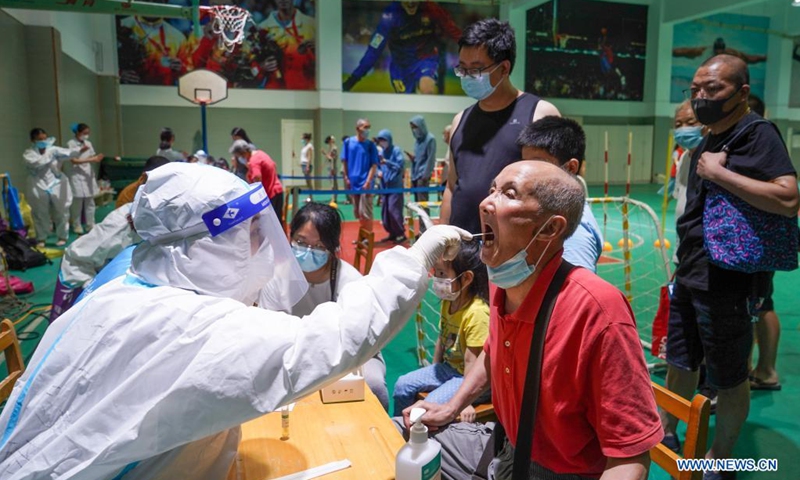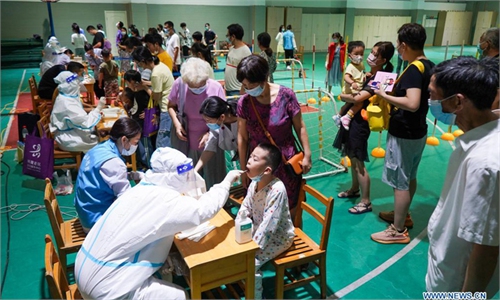
A medical worker takes a swab sample from an elderly man for COVID-19 test at a testing site in Nanjing, east China's Jiangsu Province, July 21, 2021. Nanjing, which has a population of more than 9.3 million, carried out citywide nucleic acid testing starting on Wednesday.(Photo: Xinhua)
The Nanjing COVID-19 surge will affect more places than previous outbreaks in Guangdong and Yunnan provinces, Chinese experts said, warning of the challenges that Typhoon In-Fa will pose to local anti-epidemic work.
Nanjing had detected 75 confirmed COVID-19 cases and 13 asymptomatic ones as of Sunday, mostly among employees working at the Lukou Airport, according to official information. The city had identified four high-risk regions as of Monday.
Related cases have also been detected in East China's Anhui, Northeast China's Liaoning, Southwest China's Sichuan and South China's Guangdong provinces.
Nanjing government announced to strenthen entrannce and exit management on local communities starting from Monday. Those who work at the Lukou Airport and their families, who traveled to the airport after July 10 and who had traveled to medium- and high-infection risk areas have to report to community authorities and receive health management.
A Beijing-based immunologist told the Global Times on Monday on condition of anonymity that Nanjing's outbreak would probably affect a wider scale and lead to more cases than previous ones in Guangdong and Yunnan.
It is still too early to predict how long it will take before the outbreak is put under control, as the epidemiological investigation is still in progress, said the expert.
While showing confidence in getting the outbreak under control in Nanjing, the immunologist warned about the impact of Typhoon In-Fa, which is passing over East China.
People will have to gather at relocation sites if their houses are damaged. The typhoon could also damage roads, lead to water and electricity cuts, and cause water damage. All these conditions will increase the risk of virus transmission and create difficulties in rescue and treatment, the expert explained.
Nanjing authorities have warned residents to stay at home and change their masks frequently when going outside, as wet masks are less effective.
Wang Guangfa, a respiratory expert at Peking University First Hospital, told the Global Times on Monday that unlike transmission in communities, transmission starting from the airport would affect a wider scale due to the crowds of people involved.
Wang noted that the key is to track all people who left Nanjing through the Lukou Airport two or three days before the first case occurred and their close contacts as soon as possible.
According to media reports, the start of the outbreak may have been in the airport before July 14.
Experiences from previous outbreaks in Guangdong and Yunnan showed that normally, regional outbreaks will ease within two weeks and can be controlled within one month, according to Wang.
Jin Dongyan, a biomedical professor at the University of Hong Kong, told reporters that the outbreak in Nanjing is probably a mini super-spreader event. Some cleaners got infected after coming in contact with infected items or individuals, and then spread the virus to others.
Experts said that the outbreak probably was also caused by the Delta variant, which was first found in India, as was the case in the Guangdong and Ruili outbreaks.
Meanwhile, Nanjing health authorities have not confirmed this, saying they are still analyzing the virus.

